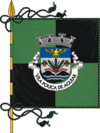Vila Pouca de Aguiar
| Vila Pouca de Aguiar | |||
|---|---|---|---|
| Municipality | |||

The ruins of the Castle of Pena de Aguiar
|
|||
|
|||
 |
|||
| Coordinates: 41°30′2″N 7°38′32″W / 41.50056°N 7.64222°WCoordinates: 41°30′2″N 7°38′32″W / 41.50056°N 7.64222°W | |||
| Country |
|
||
| Region | Norte | ||
| Subregion | Alto Trás-os-Montes | ||
| Intermunic. comm. | Alto Tâmega | ||
| District | Vila Real | ||
| Parishes | 14 | ||
| Government | |||
| • President | Alberto Machado (PPD-PSD) | ||
| Area | |||
| • Total | 437.07 km2 (168.75 sq mi) | ||
| Elevation | 797 m (2,615 ft) | ||
| Population (2011) | |||
| • Total | 13,187 | ||
| • Density | 30/km2 (78/sq mi) | ||
| Time zone | WET/WEST (UTC+0/+1) | ||
| Postal code | 5450 | ||
| Area code | 259 | ||
| Patron | Divino Salvador | ||
| Website | http://www.cm-vpaguiar.pt | ||
Vila Pouca de Aguiar (Portuguese pronunciation: [ˈvilɐ ˈpowkɐ ðɨ ɐɣiˈaɾ]) is a municipality in the district of Vila Real in northern Portugal. The population in 2011 was 13,187, in an area of 437.07 km². The town proper has about 3,456 residents.
The origin of Vila Pouca da Aguiar has caused differing opinions. Some authors hypothesis that "Vila Pouca" was the successor to the ancient city of "Cauca", which was governed by Emperor Theodosius I. Yet, this theory can not explain the name transition from Cauca to Pouca. Another belief is that "Vila Pouca" was a reference to a small agrarian community, and that "Aguiar" was a reference to an ancient administrative region. The name was, therefore, most likely, a phrase to disambiguate all the other communities named "Vila Pouca". Literally, the name means "Vila Pouca OF Aguiar", wherein etymologically, "aguiar" derived from the word aquila to designate "where the eagles are" (águia is Portuguese: eagle).
In the 13th century, the municipality of Vila Pouca de Aguiar was part of the land of Aguiar, much like other such as sites, like the Ribeira de Pena (or Portuguese: Ravine of Pena). In the 12 and 13th century, Aguiar was constituted by seven grande ecclesiastical parishes, which included São Salvador de Jugal, which corresponded to the actual parish of Vila Pouca de Aguiar. The Inquirições (inquiries/inventory) of King Afonso II established that the parochia of São Salvador de Jugal was composed of the localities and towns: Condado (three couples); Calvos (one couple); Guilhado (four couples) and Nuzedo (20 couples), in addition to the towns of Fraengo and Outeiro. The document also identifies Jugal as an administrative unit, with elaborated administrative domain over the territory of Aguiar, and where the parochial church was located, but no reference to Jugal as a town.
There is no indication as to the motives for changing the name from São Salvador de Jugal to Vila Pouca, nor the date, although it likely occurred sometime in the 14th century.
...
Wikipedia


